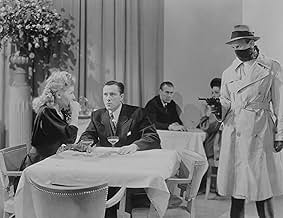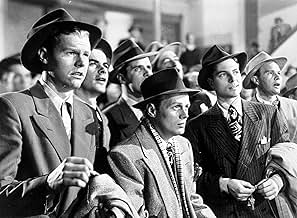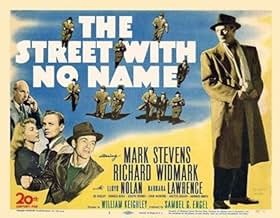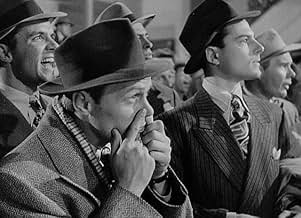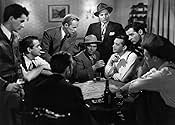IMDb RATING
7.0/10
3.4K
YOUR RATING
A covert FBI agent infiltrates a ruthless gangster mob, but his life is at risk from a mysterious informant who funnels inside information to the hoodlums.A covert FBI agent infiltrates a ruthless gangster mob, but his life is at risk from a mysterious informant who funnels inside information to the hoodlums.A covert FBI agent infiltrates a ruthless gangster mob, but his life is at risk from a mysterious informant who funnels inside information to the hoodlums.
- Awards
- 1 nomination
Larry Anzalone
- Sparring Partner
- (uncredited)
George Barrows
- Bouncer at Gym
- (uncredited)
Joan Blair
- Valentine Laval
- (uncredited)
James J. Casino
- Cornerman
- (uncredited)
Lane Chandler
- Policeman at Arcade
- (uncredited)
Dick Cherney
- Man at Gym
- (uncredited)
Noble 'Kid' Chissell
- Prisoner
- (uncredited)
Edmund Cobb
- Desk Sergeant
- (uncredited)
- Director
- Writers
- All cast & crew
- Production, box office & more at IMDbPro
Storyline
Did you know
- TriviaThe chase inside the ferry terminal was filmed in the San Pedro Municipal Ferry Terminal in Los Angeles. The building now houses the Los Angeles Maritime Museum.
- GoofsThe wall behind Ed Begley during the Danker interrogation changes from brightly lit to sharply defined shadows of prison bars and back to brightly lit again.
- Quotes
Alec Stiles: I haven't seen you around lately.
Gene Cordell: [as George Manly] I've been away.
Alec Stiles: Is that right?
Gene Cordell: Weekend in the country.
Alec Stiles: Courtesy of the city?
Gene Cordell: Something like that.
- ConnectionsFeatured in Los Angeles Plays Itself (2003)
- SoundtracksBeg Your Pardon
(uncredited)
Written by Francis Craig and Beasley Smith
Performed by Marion Marshall during the opening stick-up
Featured review
This underrated noir, efficiently handled in all departments, has rather unjustly been overshadowed by its higher-profile color remake – Samuel Fuller’s HOUSE OF BAMBOO (1955), which I’d watched before but will re-acquaint myself with now thanks to the original (scheduled as part of my ongoing Richard Widmark tribute).
The film (whose title is allegorical) deals with F.B.I. rookie Mark Stevens infiltrating a criminal gang headed by Widmark; the Bureau gave Fox (who produced it) their full co-operation: the studio, in fact, had already made THE HOUSE ON 92ND STREET (1945) in a similar vein and, though THE STREET WITH NO NAME is marked by that earlier title’s innovative semi-documentary style, it actually ties in more with the gangster pictures of the 1930s. Incidentally, director Keighley had been responsible for a number of these over at Warners – including BULLETS OR BALLOTS (1936), which I may well check out presently on the strength of my positive response to this one!; Besides, the hero’s undercover activity and the suspense inherent in such a situation anticipates Raoul Walsh’s WHITE HEAT (1949) – while its scenario, also involving the concurrent presence of a ‘rat’ operating within the Bureau itself, would be replicated nearly 60 years later in Martin Scorsese’s THE DEPARTED (2006)!
At first glance, Stevens looks like an unlikely tough guy but, in retrospect, he acquits himself surprisingly well; Widmark – in his second film – has graduated from sadistic thug to unscrupulous gang boss (memorably introduced, with his face half-hidden behind a handkerchief during a night-club ‘job’, spitting a line at the orchestra conductor: “O.K., Stokowski…dry up!”). The film is also blessed with a terrific supporting cast (including Lloyd Nolan, John McIntire and Ed Begley – all of whom play F.B.I. operatives – Donald Buka being especially noteworthy among the criminals as Widmark’s taciturn but ruthless right-hand man, and only one prominent female figure in Barbara Lawrence as the typically-abused gangster’s moll).
As expected, Joe MacDonald’s shadowy lighting emerges to be an indispensable asset here – rendered even more effective (and realistic) by locations carefully-chosen to fit the desired mood of every sequence. A remarkable outburst of violence at the film’s climax (set inside a warehouse) is equivalent, then, to the icing on the cake.
The film (whose title is allegorical) deals with F.B.I. rookie Mark Stevens infiltrating a criminal gang headed by Widmark; the Bureau gave Fox (who produced it) their full co-operation: the studio, in fact, had already made THE HOUSE ON 92ND STREET (1945) in a similar vein and, though THE STREET WITH NO NAME is marked by that earlier title’s innovative semi-documentary style, it actually ties in more with the gangster pictures of the 1930s. Incidentally, director Keighley had been responsible for a number of these over at Warners – including BULLETS OR BALLOTS (1936), which I may well check out presently on the strength of my positive response to this one!; Besides, the hero’s undercover activity and the suspense inherent in such a situation anticipates Raoul Walsh’s WHITE HEAT (1949) – while its scenario, also involving the concurrent presence of a ‘rat’ operating within the Bureau itself, would be replicated nearly 60 years later in Martin Scorsese’s THE DEPARTED (2006)!
At first glance, Stevens looks like an unlikely tough guy but, in retrospect, he acquits himself surprisingly well; Widmark – in his second film – has graduated from sadistic thug to unscrupulous gang boss (memorably introduced, with his face half-hidden behind a handkerchief during a night-club ‘job’, spitting a line at the orchestra conductor: “O.K., Stokowski…dry up!”). The film is also blessed with a terrific supporting cast (including Lloyd Nolan, John McIntire and Ed Begley – all of whom play F.B.I. operatives – Donald Buka being especially noteworthy among the criminals as Widmark’s taciturn but ruthless right-hand man, and only one prominent female figure in Barbara Lawrence as the typically-abused gangster’s moll).
As expected, Joe MacDonald’s shadowy lighting emerges to be an indispensable asset here – rendered even more effective (and realistic) by locations carefully-chosen to fit the desired mood of every sequence. A remarkable outburst of violence at the film’s climax (set inside a warehouse) is equivalent, then, to the icing on the cake.
- Bunuel1976
- Apr 8, 2008
- Permalink
- How long is The Street with No Name?Powered by Alexa
Details
- Release date
- Country of origin
- Language
- Also known as
- Manhunt
- Filming locations
- Municipal Ferry, San Pedro, California, USA(As Center City: George Manly walks down street and is tailed to ferry.)
- Production company
- See more company credits at IMDbPro
- Runtime1 hour 31 minutes
- Color
- Aspect ratio
- 1.33 : 1
Contribute to this page
Suggest an edit or add missing content

Top Gap
By what name was The Street with No Name (1948) officially released in India in English?
Answer

